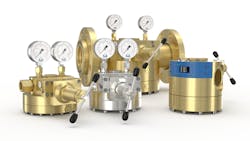Dome-Loaded Pressure Regulators Give Maximum Pressure Stability
Dome-loaded pressure regulators can deliver highly stable outlet pressure. In these devices, the required outlet pressure is regulated by means of a gas cushion instead of a spring.
The gas technology specialists at WITT have perfected this technology. But how does it work exactly, and where are the differences?
Dome-loaded pressure regulators are of enormous importance for the quality of the gas supply: Good dome-loaded pressure regulators control the gas pressure constantly even with fluctuating upstream pressures or flow rates, and can also allow high flow rates even with small pressure differences.
Stable outlet pressure means a stable process downstream.
Gas Cushion Instead of a Spring
In conventional gas pressure regulators, a simple spring provides the necessary counterforce to reduce the inlet pressure to the desired outlet pressure.
In dome-loaded regulators, on the other hand, the required counterforce is generated by gas pressure.
The so-called pilot gas forms a kind of gas cushion and presses on a diaphragm, whose movement adjusts the main valve. The gas flowing through acts behind the valve seat as a counterpart to the pilot pressure on the diaphragm.
The pilot pressure and the outlet pressure compensate for each other and achieve a stable equilibrium. The outlet pressure thus remains constant, even if the flow rate is fluctuating.
Pilot and Dome Pressure Regulator in a Single Fitting
In dynamic systems, a separate pilot pressure regulator is usually used. The user simply adjusts the pressure applied to the dome pressure regulator at any time via the pilot pressure regulator, thereby controlling the required outlet pressure.
Uniquely, WITT has integrated the pilot pressure and dome pressure regulator into a single device, a complete solution that can be installed in any position, and includes pressure gauges.
The compact regulator is fully assembled, tested, and ready for immediate use. This means minimal space requirement, as well as rapid installation and low maintenance needs, with the corresponding time and cost savings for the user.
In addition, WITT regulators have some special features: The gas to be controlled is used as the control pressure. A separate gas source is not required—a particularly uncomplicated and cost-saving procedure thanks to this "own medium control".
WITT dome-loaded pressure regulators sense the working pressure via their so-called "Pilot Control Tube" in their outlet. In other words, exactly at the point that is relevant for accurate outlet pressure control.
In addition, their "Balanced Seat Design" balances the valve position by means of the pressure on each side. Even with upstream pressure fluctuations, the outlet pressure remains constant for the user.
Furthermore, the diaphragm of WITT domes does not rest directly on the valve seat but transmits its stroke movement via a special diaphragm plate. This is key to their highly precise pressure regulation.
Constant Pressure Curve
The differences for the user are obvious: With other dome pressure regulators, the pressure curve usually drops off, i.e. the higher the flow, the greater pressure “droop”. With WITT domes, the outlet pressure remains practically unchanged over the entire possible flow range. Readjustment is not necessary.
WITT dome pressure regulators also compensate extraordinarily quickly for changes in the upstream pressure. Fluctuations of the outlet pressure or the notorious “fluttering effect” seen in other designs do not occur. The pressure loss or the pressure difference is also minimal: Even with a pressure difference of only 1 bar between upstream and downstream pressure, exact regulation is possible. This means that both very small and very large pressure differences can be controlled.
The regulators are designed and cleaned for O2 according to EIGA/CGA guidelines.
Advantages for Many Applications
The advantages of WITT dome-loaded pressure regulators can be seen in numerous applications. Whenever high degrees of pressure stability, high flow rates, and low-pressure drops are required, dome-loaded pressure regulators are the best choice.
For example, in CO2 systems for the supply of welding gases. Here, strongly fluctuating flow rates often occur, depending on how many tapping points are currently being used. With WITT dome pressure regulators, the working pressure remains stable.
The regulators are also frequently used for industrial gas supplies with high pressures, for example, downstream of a tube trailer, a tank or cylinder bundle. The low-pressure drop of the regulators allows maximum emptying of the contents, providing logistics cost savings.
But dome-loaded pressure regulators are also suitable for supplying gas to food applications or, for example, for N2 as purge gas in the chemical industry.
They are also deployed in machines, for example for correct gas metering in flame cutters. Here, the pilot gas pressure is controlled by electric proportional valves.
Advantages can also be seen in their use at the outlets of cryogenic tank vaporizers. Dome-loaded pressure regulators keep the outlet pressure constant even in case of strongly fluctuating flow rates.
Optionally, WITT dome pressure regulators are also available as "smart" pressure regulators. Integrated sensors measure the inlet and outlet pressures as well as the gas temperatures without the need for external sensors and transmitters.
The determined data of the SMART models, including the calculated flow, are shown in real time on a small display in the valve and can also be transmitted, allowing rapid intervention when action is required. This ensures maximum operational reliability and precision in the downstream process.
